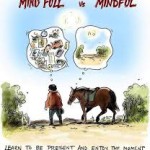How Is Mindfulness Meditation Related To The Big Bang Theory?

During a mindfulness meditation recently I had the insight that the meditation experience is in many ways parallel to the scientific theory of the Big Bang. The scientific theory of the Big Bang also parallels a number of ancient meditative and contemplative traditions as to how the universe was formed. Before I describe what I noticed in my meditation here is a definition of the scientific Big Bang theory as it presently stands.
“The Big Bang is a scientific theory about how the universe started, and then made the stars and galaxies we see today. The Big Bang is the name that scientists use for the most common theory of the universe from the very early stages to the present day.
The universe began as a very hot, small, and dense superforce (the mix of the four fundamental forces), with no stars, atoms, form, or structure (called a “singularity”). Then about 13.8 billion years ago space expanded very quickly (thus the name “Big Bang”). This started the formation of atoms, which eventually led to the formation of stars and galaxies. It was Georges LeMaitre who first noted (in 1927) that an expanding universe could be traced back in time to an originating single point. The universe is still expanding today, and getting colder as well.”
During my meditation I had the feeling that all of my energy was being gathered and concentrated into my body and that it was in a state of potential action. During meditation I also got the feeling of stillness and silence. Combined with this energy it felt like the next step was to do something with it. When I finished the meditation that focused, silent and still energy stayed with me and I realized that it was up to me to take that energy and create things with it. It was at that moment that I saw the parallel between the original point of energy in the Big Bang exploding out to create universes and the focused energy created during meditation being the driving force that helps us create things in our lives. I concluded that this is the main purpose of mindfulness meditation practice.
I now have a useful paradigm for how mindfulness meditation works as the primary driver for getting things done.
How Is Mindfulness Meditation Related To The Big Bang Theory? Read More »









